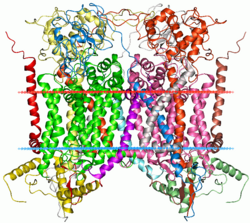
Back Citohrom b BS Citocrom b Catalan Cytochrom b German Citocromo b Spanish Tsütokroom b Estonian سیتوکروم ب Persian Cytochrome b French Citocromo b Galician Sitokrom b ID シトクロムb Japanese
| Cytochrome b, N-terminal transmembrane domain | |||||||||
|---|---|---|---|---|---|---|---|---|---|
 Mitochondrial cytochrome bc1 complex | |||||||||
| Identifiers | |||||||||
| Symbol | Cytochrom_B_N | ||||||||
| Pfam | PF00033 | ||||||||
| InterPro | IPR005797 | ||||||||
| PROSITE | PDOC00171 | ||||||||
| SCOP2 | 3bcc / SCOPe / SUPFAM | ||||||||
| TCDB | 3.D.3 | ||||||||
| OPM superfamily | 3 | ||||||||
| OPM protein | 3h1j | ||||||||
| CDD | cd00284 | ||||||||
| |||||||||
| Cytochrome b, C-terminal domain | |||||||||
|---|---|---|---|---|---|---|---|---|---|
 Mitochondrial cytochrome bc1 complex | |||||||||
| Identifiers | |||||||||
| Symbol | Cytochrom_B_C | ||||||||
| Pfam | PF00032 | ||||||||
| InterPro | IPR005798 | ||||||||
| |||||||||
Cytochrome b within both molecular and cell biology, is a protein found in the membranes of aerobic cells. In eukaryotic mitochondria (inner membrane) and in aerobic prokaryotes, cytochrome b is a component of respiratory chain complex III (EC 1.10.2.2) — also known as the bc1 complex or ubiquinol-cytochrome c reductase. In plant chloroplasts and cyanobacteria, there is an homologous protein, cytochrome b6, a component of the plastoquinone-plastocyanin reductase (EC 1.10.99.1), also known as the b6f complex. These complexes are involved in electron transport, the pumping of protons to create a proton-motive force (PMF). This proton gradient is used for the generation of ATP. These complexes play a vital role in cells.[1][2][3]
- ^ Blankenship, Robert (2009). Molecular Mechanisms of Photosynthesis. Blackwell Publishing. pp. 124–132.
- ^ Howell N (August 1989). "Evolutionary conservation of protein regions in the proton motive cytochrome b and their possible roles in redox catalysis". J. Mol. Evol. 29 (2): 157–69. Bibcode:1989JMolE..29..157H. doi:10.1007/BF02100114. PMID 2509716. S2CID 7298013.
- ^ Esposti MD, De Vries S, Crimi M, Ghelli A, Patarnello T, Meyer A (July 1993). "Mitochondrial cytochrome b: evolution and structure of the protein" (PDF). Biochim. Biophys. Acta. 1143 (3): 243–71. doi:10.1016/0005-2728(93)90197-N. PMID 8329437.